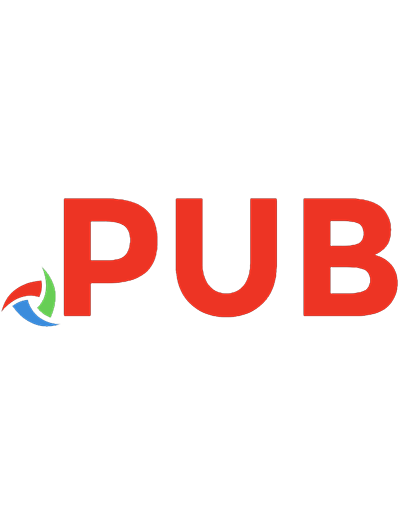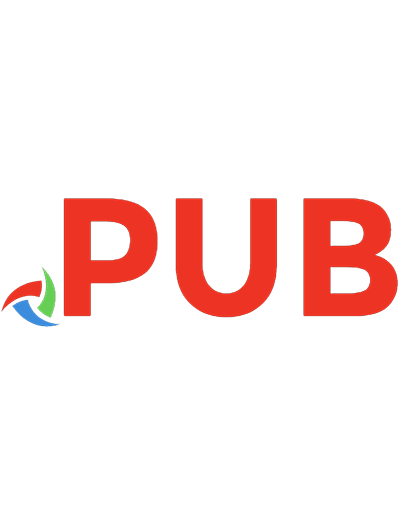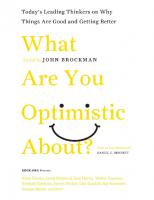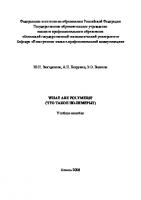Nothing Loopy About This: What Are Loops and Conditionals? 2018022634, 2018028098, 9781541543867, 9781541533073, 9781541545588
Can cats code? These cats sure can! Find out all about loops and conditionals, presented with playful rhyming verse and
262 118 6MB
English Pages 28 Year 2019
Polecaj historie
Citation preview
an code? c s t Ca These cats sure can!
Find out all about loops and conditionals, presented with playful rhyming verse and goofy illustrations. Readers will learn how loops and conditionals can save coders time, with lots of examples from everyday life. If loops and conditionals are throwing you for a loop, then this is just the book for you! Author Brian P. Cleary, illustrator Martin Goneau, and the enthusiastic CATegorical cats offer a fun and accessible introduction to these key coding concepts.
Ages 5–9
Reinforced binding
by Brian P. Cleary illustrations by Martin Goneau
J Millbrook Press • Minneapolis
giving computers and a s n a e m pps g n i d set of command a s e o t i s b e C a nd w s
2
that tells them exactly what each one should do using language that it understands. 3
f those coded instr o t r a p uction sa i p s , o o a l l w o a t y s repeat job is A s t i a nd
4
a portion of code a set number of times and then stop when the task is complete.
5
Loops can save coders a great deal of time on work that could go on forever, like giving the same command eight million times. 6
en you’d finish tha h w w o n t? k u o Y Never!
7
So maybe instead of programming a robot to top just one cupcake with frosting,
8
a LOOP could repeat thirty times and you’d have thirty done, but it’s much less exhausting!
9
A loop in the code tells a feeder to fill this dish here at eight, noon, and six
10
each day all year through— just by telling it once. Loops are one of a coder’s main tricks!
11
A whole set of rules that is put into action if something occurs has a name:
12
it’s called a conditional—and it’s pretty cool— it plays an “if . . . then” kind of game.
13
Like, “If the temperature’s higher than 15, then recess will be outside, teachers!
14
But if it is 15 or lower, then recess will be in the gym, near the bleachers.”
15
help when you’ s l a n o i t re di n o C d e. o c a g n i writ e if and then to ma s ke rule u l l ’ s, You 16
like telling the self-driving car you’re designing to lower its speed around schools. 17
The code might say if it’s between certain hours and a school is within 90 feet,
18
then the car will slow down—and will come to a stop one is crossing the str e m o s eet. if
19
itionals lend a big d n o c h a nd nd a s p o pros of all age g n i t i r Lo w s, de o c to 20
like YOU to write software, create fun, new games, own apps or web r u o y e pages ak m ! r o 21
loops and e r a t ha w So ditionals? con
Do you know?
Coding is fun! And best of all, anyone can do it! All you need is a computer or tablet, an internet connection, and a willingness to try. As you read in this book, loops are sets of instructions that repeat a certain number of times. They’re useful in programming repetitive tasks, such as instructing a car to go around a racetrack multiple times. Conditionals let programs respond to different circumstances by telling them to do one thing if a situation is true and another if it is false.
Loops and conditionals make it easier to do things like: • • • •
• know when your shelve library books car needs gas build cars in a factory listen to a song again • take an online personality test play a video game
Loops and conditionals save you time and make mistakes less likely. Coding languages that use block coding, such as Scratch and Alice, help make things even easier, because you can drag and drop “blocks” of code to write your program. It’s best to start with something simple. Don’t worry if your code isn’t perfect from the get-go. The more you practice, the easier it will be!
22
learn more? o t t Wa n
Check out these great resources!
Books
Liukas, Linda. Hello, Ruby: Adventures in Coding. New York: Feiwel and Friends, 2015. This picture and activity book for new coders introduces the basics of computational thinking, such as breaking big problems into smaller ones, finding patterns, and creating step-by-step plans. Loya, Allyssa. Disney Coding Adventures: First Steps for Kid Coders. Minneapolis: Lerner Publications, 2019. Friendly Disney characters introduce kid coders to the basic concepts of algorithms, bugs and errors, loops, and conditionals. Hands-on activities throughout the book add to the fun. Robinson, Fiona. Ada’s Ideas: The Story of Ada Lovelace, the World’s First Computer Programmer. New York: Abrams Books for Young Readers, 2016. This picture book biography introduces trailblazer Ada Byron Lovelace. She loved math and science, and she created the first computer program—even before electronic computers existed.
Websites and Apps
Code.org https://code.org This site has lots of resources for anyone who wants to start coding—including students and their teachers. Check out the “Projects” tab to see what other kids have done and take a look at the code for these projects. Scratch Jr. https://www.scratchjr.org This simple, block-based programming language was created especially for early elementary students who don’t have any previous coding experience. It runs on both iPads and Android tablets.
23
ABOUT THE AUTHOR & THE ILLUSTRATOR BRIAN P. CLEARY is the author of the best-selling Words Are CATegorical® series, as well as the Sounds Like Reading® series, the Poetry Adventures series, and several others. He is also the author of Crunch and Crack, Oink and Whack! An Onomatopoeia Story and The Sun Played Hide-and-Seek: A Personification Story. He lives in Cleveland, Ohio. MARTIN GONEAU is the illustrator of many books, including quite a number in the Words Are CATegorical™ series. When he is not drawing, he enjoys playing video games and learning how to code. He lives in Trois-Rivières, Québec, with his lovely wife and his two sons. Thank you to technical expert Michael Miller for reviewing the text and illustrations. Text copyright © 2019 by Brian P. Cleary Illustrations copyright © 2019 by Lerner Publishing Group, Inc. All rights reserved. International copyright secured. No part of this book may be reproduced, stored in a retrieval system, or transmitted in any form or by any means—electronic, mechanical, photocopying, recording, or otherwise—without the prior written permission of Lerner Publishing Group, Inc., except for the inclusion of brief quotations in an acknowledged review. Millbrook Press A division of Lerner Publishing Group, Inc. 241 First Avenue North Minneapolis, MN 55401 USA For reading levels and more information, look up this title at www.lernerbooks.com. Main body text set in Chauncy Decaf Medium 27/36. Typeface provided by the Chank Company. The illustrations in this book were created in Adobe Photoshop using a Wacom Cintiq Pro 16. Library of Congress Cataloging-in-Publication Data Names: Cleary, Brian P., 1959– author. | Goneau, Martin, illustrator. Title: Nothing loopy about this : what are loops and conditionals? / Brian P. Cleary ; iIllustrated by Martin Goneau. Description: Minneapolis : Millbrook Press, [2019] | Series: Coding Is CATegorical | Audience: Age 5–9. | Audience: K to Grade 3. | Includes bibliographical references and index. Identifiers: LCCN 2018022634 (print) | LCCN 2018028098 (ebook) | ISBN 9781541543867 (eb pdf) | ISBN 9781541533073 (lb : alk. paper) | ISBN 9781541545588 (pb : alk. paper) Subjects: LCSH: Loop tiling (Computer science)—Juvenile literature. | Conditionals (Logic)—Juvenile literature. | Computer programming—Juvenile literature. Classification: LCC QA76.6115 (ebook) | LCC QA76.6115 .C44 2019 (print) | DDC 005.4/53—dc23 LC record available at https://lccn.loc.gov/2018022634 Manufactured in the United States of America 1-44876-35726-10/9/2018
Brian P. Cleary is the author of the best-selling Words Are CATegorical® series, as well as the Sounds Like Reading® series, the Poetry Adventures series, and several others. He is also the author of Crunch and Crack, Oink and Whack! An Onomatopoeia Story and The Sun Played Hide-and-Seek: A Personification Story. He lives in Cleveland, Ohio. Martin Goneau is the illustrator of many books, including quite a number in the Words Are CATegorical™ series. When he is not drawing, he enjoys playing video games and learning how to code. He lives in Trois-Rivières, Québec with his lovely wife and his two sons.
Jacket illustrations by Martin Goneau
j Millbrook Press
A DIVISION OF LERNER
PUBLISHING GROUP
241 First Avenue North • Minneapolis, MN 55401 www.lernerbooks.com Printed and bound in USA
Bugs That Make Your Computer Crawl: What Are Computer Bugs?
Nothing Loopy about This: What Are Loops and Conditionals?
This Python Isn’t a Snake: What Are Coding Languages and Syntax?
You Can’t Dance to These Rhythms: What Are Algorithms?





![After This Life: What Catholics Believe about What Happens Next [Paperback ed.]
1592764428, 9781592764426](https://dokumen.pub/img/200x200/after-this-life-what-catholics-believe-about-what-happens-next-paperbacknbsped-1592764428-9781592764426.jpg)




